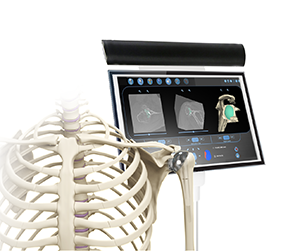GPS-guided Shoulder Replacement

What is GPS-guided Shoulder Replacement?
For a successful total shoulder replacement, accurate positioning of the implants is crucial to accomplish a good clinical outcome. Guided Personalized Surgery or GPS-guided shoulder replacement is an advanced technology developed to provide more accurate positioning of an implant. Shoulder replacement through GPS guidance provides information and guidance to the surgeon for the precise positioning of implants.
Anatomy of the Shoulder
The shoulder is a highly movable body joint that allows various movements of the arm. It is a ball and socket joint, where the head of the humerus (upper arm bone) articulates with the socket of the scapula (shoulder blade), which is called the glenoid. The two articulating surfaces of the bones are covered with cartilage, which prevents friction between the moving bones. The cartilage is lubricated by synovial fluid. Tendons and ligaments around the shoulder joint provide strength and stability to the joint.
Indications for GPS-guided Shoulder Replacement
Indications for a GPS-guided shoulder replacement include:
- Failed total shoulder replacement
- Failed reverse total shoulder replacement
- Mobility issues
Procedure for GPS-guided Shoulder Replacement
This technological advancement allows for significant improvements in the planning and surgical accuracy of shoulder replacement surgery. The shoulder replacement is planned prior to the surgery using a virtual 3D model created by a CT scan of the shoulder. This plan is then implemented using computer guidance and navigation during the surgery, leading to a very precise and accurate placement of the shoulder components. Computer navigation provides real-time imaging of the affected joint and surgical instruments during surgery. Data for the images are provided by infrared sensors fixed to the bones of the joint and the surgical instruments. Their position is tracked by an infrared camera situated above the surgical table linked to the computer and guides the surgeon’s progress.
What are the Advantages of GPS-guided Shoulder Replacement?
Some of the advantages of GPS-guided Shoulder Replacement include:
- Greater visibility
- Consistent and accurate positioning of the implant
- The surgery can be planned through a virtual simulation prior to surgery
- Minimal chance of implant displacement
- More precise, simpler and less invasive
- Less expensive than traditional shoulder replacement surgery
- Quicker healing





